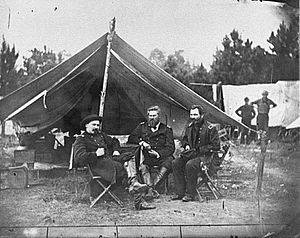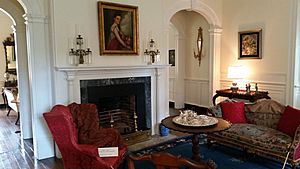Berkeley Plantation facts for kids
|
Berkeley Plantation
|
|

House from the South (river) side
|
|
| Location | 8 mi. W of Charles City, Charles City County, Virginia |
|---|---|
| Area | 650 acres (260 ha) |
| Built | 1726 |
| Architectural style | Georgian |
| NRHP reference No. | 71001040 |
Quick facts for kids Significant dates |
|
| Designated NHL | November 11, 1971 |
Berkeley Plantation is one of America's oldest and most famous homes. It sits on about 1,000 acres of land next to the James River in Charles City County, Virginia. This historic place was once called Berkeley Hundred, named after a company from England.
In 1726, the Harrison family of Virginia made Berkeley their home. Benjamin Harrison IV built a large, three-story brick mansion there. This house became the birthplace of two presidents of the United States: William Henry Harrison (born in 1773) and his grandson, Benjamin Harrison.
Today, Berkeley Plantation is a museum. Visitors can explore its history and beautiful grounds.
Berkeley Plantation is famous for several "firsts" in American history:
- In 1619, settlers held the first annual Thanksgiving celebration here after arriving from England.
- In 1862, during the American Civil War, the famous Army bugle call "Taps" was first played at Berkeley.
Contents
The Story of Berkeley Plantation
The story of Berkeley Plantation began in 1618. The Virginia Company of London gave a large piece of land, about 8,000 acres, to a group of English gentlemen. This land was called the Berkeley Hundred. It was located on the north side of the James River, not far from Jamestown, which was the first permanent English settlement in Virginia. The area was named after Richard Berkeley, one of the original founders.
America's First Thanksgiving
In 1619, a ship called the Margaret arrived at Berkeley Hundred with 38 new settlers. Their charter, which was like a set of rules, said that their arrival day must be a day of thanksgiving to God. So, on December 4, 1619, Captain John Woodlief led a special service. This event is considered one of the first recorded celebrations of Thanksgiving in the United States. It happened two years before the Pilgrims celebrated their Thanksgiving in Plymouth, Massachusetts in 1621.
Early Challenges and Growth
In 1622, Native Americans from the Powhatan Confederacy attacked English settlements along the James River. Nine colonists at Berkeley were killed. Many settlements were destroyed, and survivors fled to Jamestown.
By 1634, the area around Berkeley became part of Charles City County. This is one of the oldest counties in the United States. It is located along Virginia State Route 5, which passes many historic plantations.
The Harrison Family Home
After several changes in ownership, a part of Berkeley Hundred was bought by Benjamin Harrison III. His son, Benjamin Harrison IV, built the grand three-story brick mansion that stands today. He used bricks that were made right on the plantation! This house became the center of the powerful Harrison family.

Benjamin Harrison V, who was born at Berkeley, became a signer of the United States Declaration of Independence and a governor of Virginia. His son, William Henry Harrison, was also born here. William Henry Harrison became a war hero and the ninth president of the United States. Later, his grandson, Benjamin Harrison, became the 23rd president. This makes Berkeley Plantation a special place, as it's the ancestral home of two U.S. presidents.
Many early American presidents visited the Harrison family at Berkeley. These include George Washington, John Adams, Thomas Jefferson, James Madison, James Monroe, John Quincy Adams, Andrew Jackson, Martin Van Buren, and John Tyler.
The Civil War and "Taps"
By 1799, the land at Berkeley was worn out from growing tobacco and cotton for many years. The plantation faced financial problems. Eventually, the Harrison family lost ownership of Berkeley.
During the American Civil War, Union soldiers took over Berkeley Plantation. President Abraham Lincoln visited twice in 1862 to meet with General George B. McClellan. It was also during this time, in 1862, that the famous bugle call "Taps" was created and first played at Berkeley.
Bringing Berkeley Back to Life
After the Civil War, the plantation was in very bad shape. The mansion was even used as a barn! It was almost falling apart.
In 1907, John Jamieson, a man who had been a drummer boy at Berkeley during the Civil War, bought the property. His son, Malcolm, inherited it in 1925. Malcolm and his wife, Grace, spent many years and a lot of money restoring the ruined mansion. By 1938, it was a beautiful home again.
Today, the ground floor of the mansion is a museum. It attracts visitors from all over the world. The house is filled with antique furniture from the time it was built. The gardens have also been restored, and you can even get cuttings from the historic boxwood hedges as souvenirs.
Berkeley is still a working farm, growing crops like corn, soybeans, and wheat. There is also a small family cemetery on the property where some of the Harrisons and Jamiesons are buried.
In 2018, reconstructed slave quarters were built on the property for a movie about Harriet Tubman called Harriet. The original quarters were no longer there.
Exploring the Outside of Berkeley
The main house is surrounded by ten acres of beautiful formal gardens. There are tall boxwood hedges that create pathways. Large gates with decorative spires welcome visitors.
The house itself is made of red brick. It has two stories, with the main entrance in the middle. Symmetrical windows are on each side of the door and above it. The roof has a classic gabled shape with three dormer windows and two large brick chimneys.
The grounds also include a two-story guest house. In 1862, during the Civil War, Confederate soldiers fired a cannonball at the guest house from the nearby James River. The cannonball is still stuck in the side of the house today, marked with a small sign!
-
The side of the Guest House showing a 1862 cannonball from J.E.B. Stuart's Cavalry during the Peninsula campaign.
See also









